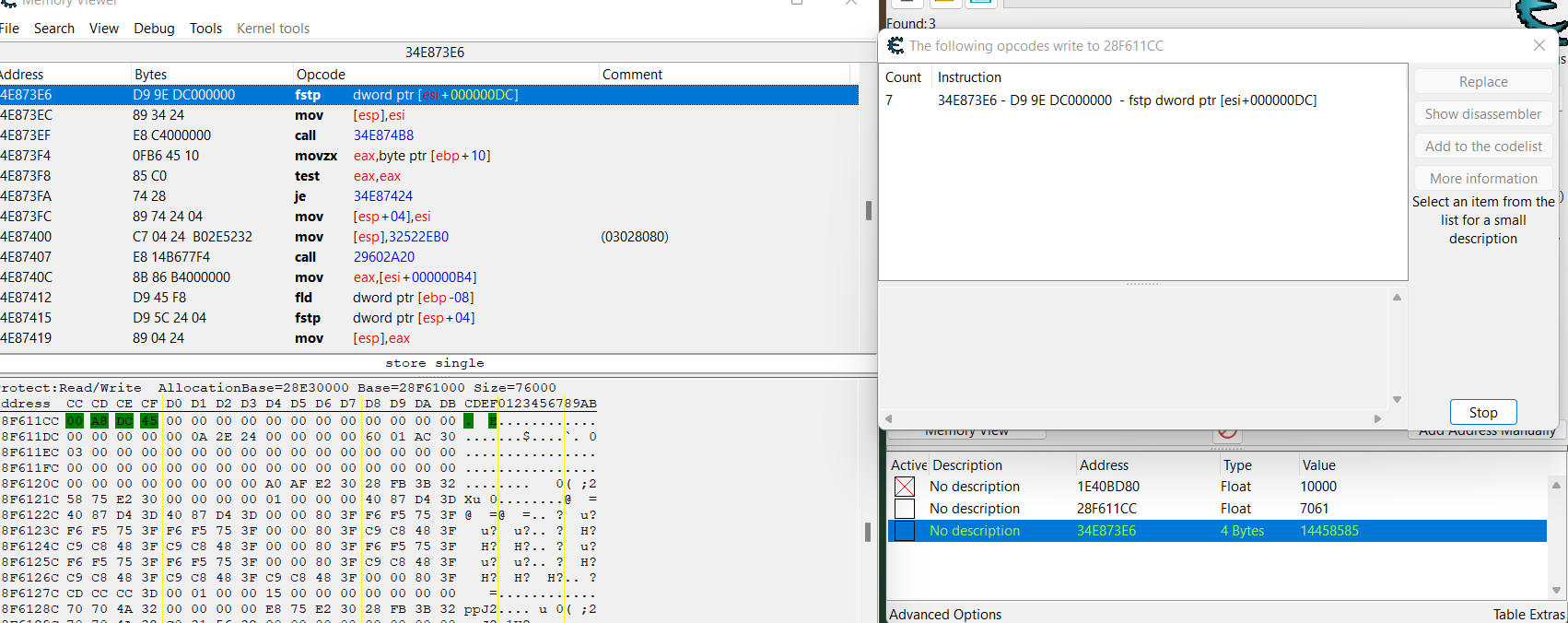Sunmoon
How do I cheat?
![]() Reputation: 0 Reputation: 0
Joined: 17 Jan 2023
Posts: 4
|
 Posted: Wed Jan 25, 2023 12:37 am Post subject: How To find encrypted value and edit it. Posted: Wed Jan 25, 2023 12:37 am Post subject: How To find encrypted value and edit it. |
 |
|
I want to edit exp in this game, i search using the process of elimination but only find the display value (the value will revert back), so the exp value must be encrypted. so I scan which address write to this address and find this (picture) and I open it in memory viewer. now what? which one is the address that containing the encrypted exp value?
since the information that I get is just 34E873E6 - D9 DC000000 - fstp dword ptr [esi + 000000DC]" what does it means?
| Description: |
|
| Filesize: |
122.87 KB |
| Viewed: |
2636 Time(s) |

|
|
|
Csimbi
I post too much
 Reputation: 97 Reputation: 97
Joined: 14 Jul 2007
Posts: 3325
|
 Posted: Wed Jan 25, 2023 5:38 am Post subject: Posted: Wed Jan 25, 2023 5:38 am Post subject: |
 |
|
You should read the Intel Instruction Manual.
It says:
| Quote: | The FST instruction copies the value in the ST(0) register to the destination operand,
which can be a memory location or another register in the FPU register stack. When
storing the value in memory, the value is converted to single-precision or doubleprecision
floating-point format.
The FSTP instruction performs the same operation as the FST instruction and then
pops the register stack. To pop the register stack, the processor marks the ST(0)
register as empty and increments the stack pointer (TOP) by 1. The FSTP instruction
can also store values in memory in double extended-precision floating-point format.
If the destination operand is a memory location, the operand specifies the address
where the first byte of the destination value is to be stored. If the destination
operand is a register, the operand specifies a register in the register stack relative to
the top of the stack.
If the destination size is single-precision or double-precision, the significand of the
value being stored is rounded to the width of the destination (according to the
rounding mode specified by the RC field of the FPU control word), and the exponent
is converted to the width and bias of the destination format. If the value being stored
is too large for the destination format, a numeric overflow exception (#O) is generated
and, if the exception is unmasked, no value is stored in the destination operand.
If the value being stored is a denormal value, the denormal exception (#D) is not
generated. This condition is simply signaled as a numeric underflow exception (#U)
condition.
If the value being stored is ±0, ±∞, or a NaN, the least-significant bits of the significand
and the exponent are truncated to fit the destination format. This operation
preserves the value’s identity as a 0, ∞, or NaN.
If the destination operand is a non-empty register, the invalid-operation exception is
not generated.
This instruction’s operation is the same in non-64-bit modes and 64-bit mode. |
It's not an encypted value, it's a simple floating point number.
|
|

 Reputation: 97
Reputation: 97

